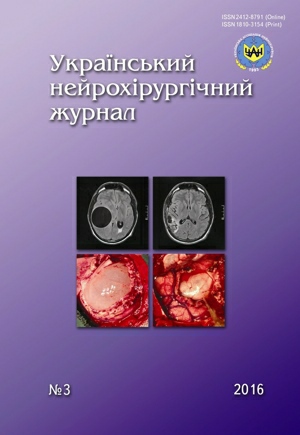The concept of limb function recovery in traumatic injury of peripheral nerves
DOI:
https://doi.org/10.25305/unj.78784Keywords:
traumatic injuries of peripheral nerves, restore function of the limbAbstract
Purpose. To develop key principles in the treatment of traumatic injury of peripheral nerves basing on analysis of injury of peripheral nerves severity, and structural and functional condition of muscles.
Materials and methods. We analyzed the results of treatment of 726 patients with injury of peripheral nerves of the extremities. Injury of the upper extremity had 345 (47.5%) patients, with lower limb trauma 381 (52.5%) patients. Electromyography study was performed to 460 patients on “Neuroscreen” (Toenis, Germany) and “Viking Quest” (Nicollet, USA). Ultrasound of muscles was performed to 185 patients on HDI 3500 device and HD 11 XE (Philips) with a multifrequency linear transducer (5–12 MHz).
Results. In 70.2 % of cases, nerve injury has polystructural injury of two or more anatomical and functional structures. Based on the analysis of clinical examination, ultrasound and EMG data characteristics we proposed the concept of the treatment of peripheral nerve injuries in limbs trauma and highlighted its main points: the definition of the level and severity of the nerve damage, forecast its recovery and muscle reinnervation; assessment of the nature and degree of severity of the key muscle (denervation or a combination of several pathological processes), assessment of damage to other structures of the injured limb segment allowing for the polystructural injury treatment algorithm.
References
1. Vishnevskiy V.O. [Reasons and diagnostic errors in cases of the peripheral nerves of extremities injuring]. Zaporozhye Medical Journal. 2014;4(85):50-5. Ukrainian. [CrossRef]
2. Wojtkiewicz DM, Saunders J, Domeshek L, Novak CB, Kaskutas V, Mackinnon SE. Social impact of peripheral nerve injuries. Hand (NY). 2015;10(2):161-7. [CrossRef] [PubMed]
3. Hayko OH. Strukturno-funktsionalni porushennya u myazakh khvorykh z travmoyu kintsivok (diahnostyka, monitorynh ta prohnozuvannya perebihu) [Structural and functional disorders in muscles of patients with limb injuries (diagnosis, monitoring and prognosis)]. [dissertation]. Kiev (Ukraine): Institute of Traumatology and Orthopedics; 2013. Ukrainian.
4. Toia F, Moschella F, Cillino M, Gagliardo A, Maggi F, Mariolo A. Clinical neurophysiology and imaging of nerve injuries: preoperative diagnostic work-up and postoperative monitoring. Plast Aesthet Res. 2015;21:49-55. [CrossRef]
5. Hecht BM. Teoreticheskaya i klinicheskaya elektromiografiya [Theoretical and clinical electromyography]. Leningrad: Science; 1990. Russian.
6. Simon NG, Ralph JW, Lomen-Hoerth C, Poncelet AN, Vucic S, Kiernan MC, Kliot M. Quantitative ultrasound of denervated hand muscles. Muscle & Nerve. 2015;52(2):221-30. [CrossRef] [PubMed]
7. Gayko OG, Strafun SS, Gayovich VV, Vovchenko GY. [Sonographic investigation of muscles in patients with sequences of peripheral nerves injury]. Journal of Orthopedics, Traumatology and Prosthetics. 2013;1:42-7. Ukrainian. Available at: http://nbuv.gov.ua/UJRN/Votip_2013_1_12
8. Grinsell D, Keating CP. Peripheral nerve reconstruction after injury: a review of clinical and experimental therapies / Biomed Res Int. 2014;2014:698256. [CrossRef] [PubMed]
9. Chebotareva LL. Komplexna diagnostika travmatychnyh urazen plechovogo spletennya I peripherichnih nerviv ta control vidnovlennya ih funkcii [Complex diagnosis of traumatic lesions of the brachial plexus and peripheral nerve recovery and control their functions] [dissertation]. Kiev (Ukraine): Romodanov Neurosurgery Institute; 1998. Ukrainian.
10. Strafun SS. Kliniko-electromiographichni ta sonographicni criterii u viznachenni tactiki likuvannya chvorich z ushkodzhennyam peripherichnich nerviv vnaslidok travmi kincivok [Clinical, electromyographic and sonographic criteria in the selection of treatment strategy for patients with peripheral nerve injury due to travma of the limbs. Travma. 2013;4(14):75-9. Ukrainian. Available at: http://nbuv.gov.ua/UJRN/Travma_2013_14_4_18
11. Tsymbaliuk VI, Chebotareva LL, Strafun SS. Elektromiohrafichni kryteriyi efektyvnosti reinnervatsiyi pislya khirurhichnoho likuvannya khvorykh z travmoyu plechovoho spletennya [Electromyographic performance criteria reinervatsiyi after surgical treatment of brachial plexus injury]. Bulletin UAN. 1998(4):87-92. Ukrainian.
12. Feinberg J. EMG: myths and facts. HSSJ. 2006;2(1):19-21. [CrossRef] [PubMed]
13. Strafun SS, Gayko OG. Kliniko-elektromiohrafichni stadiyi denervatsiyno-reinnervatsiynoho protsesu u m’yazakh kintsivok pry ushkodzhenni peryferychnykh nerviv [Clinical and electromyographic stages of denervation and reinnervation process in muscles in peripheral nerve injures of the limbs]. Travma. 2012;13(4):121-7. Ukrainian. Available at: http://www.mif-ua.com/archive/article/34666
14. Tsymbaliuk VI, Mogila VV, Nicholas ZhI. [Principles of surgical treatment of traumatic lesions of the median nerve at different levels]. Ukr Med Chasopis. 2005;47(3):64-8. Russian.
Downloads
Published
How to Cite
Issue
Section
License
Copyright (c) 2016 Vitaliy Tsymbaliuk, Sergiy Strafun, Oksana Haiko, Vasil Gaiovych

This work is licensed under a Creative Commons Attribution 4.0 International License.
Ukrainian Neurosurgical Journal abides by the CREATIVE COMMONS copyright rights and permissions for open access journals.
Authors, who are published in this Journal, agree to the following conditions:
1. The authors reserve the right to authorship of the work and pass the first publication right of this work to the Journal under the terms of Creative Commons Attribution License, which allows others to freely distribute the published research with the obligatory reference to the authors of the original work and the first publication of the work in this Journal.
2. The authors have the right to conclude separate supplement agreements that relate to non-exclusive work distribution in the form of which it has been published by the Journal (for example, to upload the work to the online storage of the Journal or publish it as part of a monograph), provided that the reference to the first publication of the work in this Journal is included.









